Analysis of Leadership and Management Roles in M&S Operations
VerifiedAdded on 2020/06/06
|15
|3836
|153
Report
AI Summary
This report examines the roles and characteristics of leaders and managers, contrasting their responsibilities and comparing their approaches. Focusing on Marks & Spencer (M&S), the report analyzes how leadership and management functions within an operations context, including situational, systems, and contingency leadership models. It explores key approaches to operations management, such as Total Quality Management (TQM) and Just-in-Time, and how leaders and managers utilize these approaches to achieve business objectives. The report also investigates factors impacting operational management within M&S, providing insights into how the company adapts to challenges. The analysis highlights the importance of operations management in enhancing product quality, maintaining customer relationships, and achieving a competitive advantage. The report concludes by emphasizing the significance of effective leadership and management in driving organizational success within the dynamic retail environment.
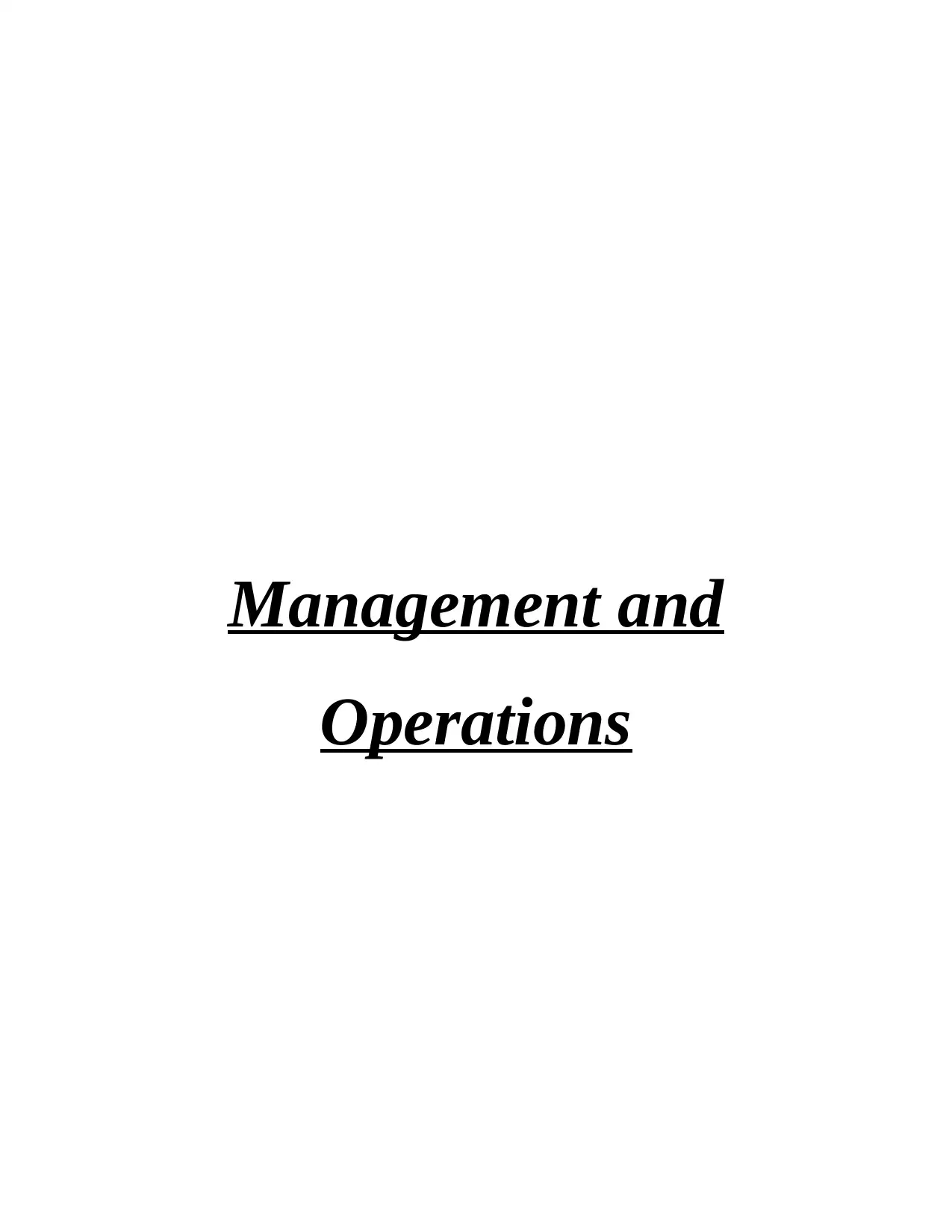
Management and
Operations
Operations
Paraphrase This Document
Need a fresh take? Get an instant paraphrase of this document with our AI Paraphraser
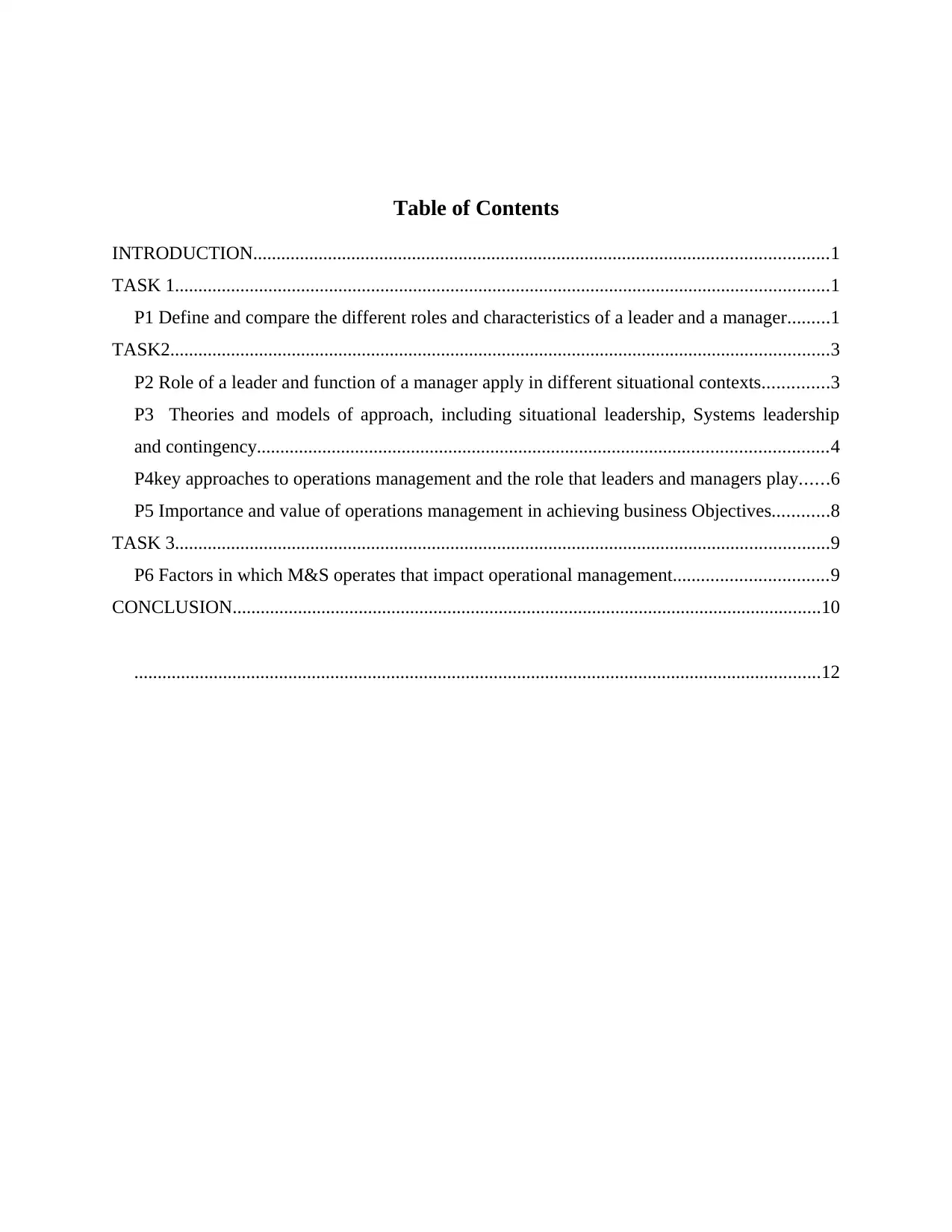
Table of Contents
INTRODUCTION...........................................................................................................................1
TASK 1............................................................................................................................................1
P1 Define and compare the different roles and characteristics of a leader and a manager.........1
TASK2.............................................................................................................................................3
P2 Role of a leader and function of a manager apply in different situational contexts..............3
P3 Theories and models of approach, including situational leadership, Systems leadership
and contingency..........................................................................................................................4
P4key approaches to operations management and the role that leaders and managers play......6
P5 Importance and value of operations management in achieving business Objectives............8
TASK 3............................................................................................................................................9
P6 Factors in which M&S operates that impact operational management.................................9
CONCLUSION..............................................................................................................................10
...................................................................................................................................................12
INTRODUCTION...........................................................................................................................1
TASK 1............................................................................................................................................1
P1 Define and compare the different roles and characteristics of a leader and a manager.........1
TASK2.............................................................................................................................................3
P2 Role of a leader and function of a manager apply in different situational contexts..............3
P3 Theories and models of approach, including situational leadership, Systems leadership
and contingency..........................................................................................................................4
P4key approaches to operations management and the role that leaders and managers play......6
P5 Importance and value of operations management in achieving business Objectives............8
TASK 3............................................................................................................................................9
P6 Factors in which M&S operates that impact operational management.................................9
CONCLUSION..............................................................................................................................10
...................................................................................................................................................12

⊘ This is a preview!⊘
Do you want full access?
Subscribe today to unlock all pages.

Trusted by 1+ million students worldwide
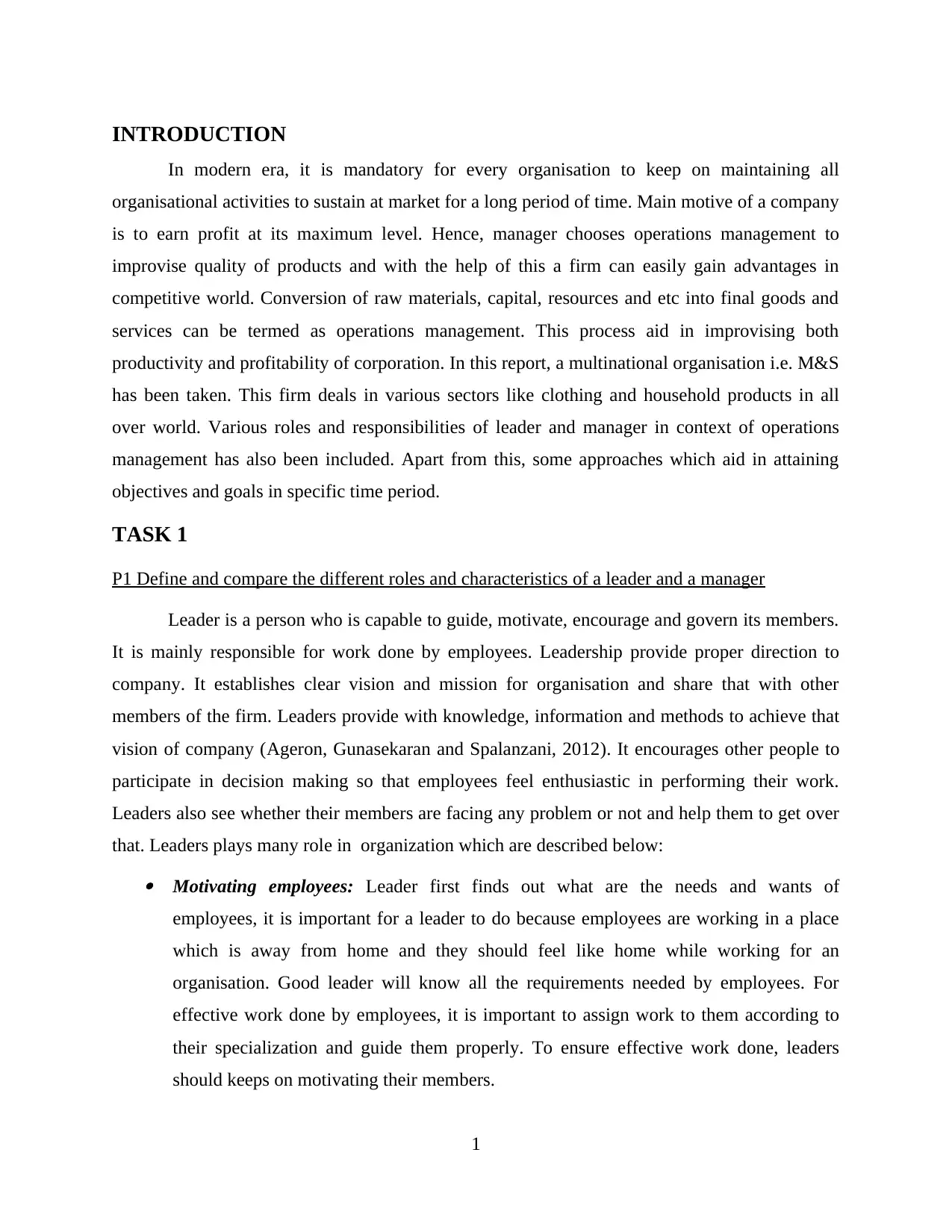
INTRODUCTION
In modern era, it is mandatory for every organisation to keep on maintaining all
organisational activities to sustain at market for a long period of time. Main motive of a company
is to earn profit at its maximum level. Hence, manager chooses operations management to
improvise quality of products and with the help of this a firm can easily gain advantages in
competitive world. Conversion of raw materials, capital, resources and etc into final goods and
services can be termed as operations management. This process aid in improvising both
productivity and profitability of corporation. In this report, a multinational organisation i.e. M&S
has been taken. This firm deals in various sectors like clothing and household products in all
over world. Various roles and responsibilities of leader and manager in context of operations
management has also been included. Apart from this, some approaches which aid in attaining
objectives and goals in specific time period.
TASK 1
P1 Define and compare the different roles and characteristics of a leader and a manager
Leader is a person who is capable to guide, motivate, encourage and govern its members.
It is mainly responsible for work done by employees. Leadership provide proper direction to
company. It establishes clear vision and mission for organisation and share that with other
members of the firm. Leaders provide with knowledge, information and methods to achieve that
vision of company (Ageron, Gunasekaran and Spalanzani, 2012). It encourages other people to
participate in decision making so that employees feel enthusiastic in performing their work.
Leaders also see whether their members are facing any problem or not and help them to get over
that. Leaders plays many role in organization which are described below: Motivating employees: Leader first finds out what are the needs and wants of
employees, it is important for a leader to do because employees are working in a place
which is away from home and they should feel like home while working for an
organisation. Good leader will know all the requirements needed by employees. For
effective work done by employees, it is important to assign work to them according to
their specialization and guide them properly. To ensure effective work done, leaders
should keeps on motivating their members.
1
In modern era, it is mandatory for every organisation to keep on maintaining all
organisational activities to sustain at market for a long period of time. Main motive of a company
is to earn profit at its maximum level. Hence, manager chooses operations management to
improvise quality of products and with the help of this a firm can easily gain advantages in
competitive world. Conversion of raw materials, capital, resources and etc into final goods and
services can be termed as operations management. This process aid in improvising both
productivity and profitability of corporation. In this report, a multinational organisation i.e. M&S
has been taken. This firm deals in various sectors like clothing and household products in all
over world. Various roles and responsibilities of leader and manager in context of operations
management has also been included. Apart from this, some approaches which aid in attaining
objectives and goals in specific time period.
TASK 1
P1 Define and compare the different roles and characteristics of a leader and a manager
Leader is a person who is capable to guide, motivate, encourage and govern its members.
It is mainly responsible for work done by employees. Leadership provide proper direction to
company. It establishes clear vision and mission for organisation and share that with other
members of the firm. Leaders provide with knowledge, information and methods to achieve that
vision of company (Ageron, Gunasekaran and Spalanzani, 2012). It encourages other people to
participate in decision making so that employees feel enthusiastic in performing their work.
Leaders also see whether their members are facing any problem or not and help them to get over
that. Leaders plays many role in organization which are described below: Motivating employees: Leader first finds out what are the needs and wants of
employees, it is important for a leader to do because employees are working in a place
which is away from home and they should feel like home while working for an
organisation. Good leader will know all the requirements needed by employees. For
effective work done by employees, it is important to assign work to them according to
their specialization and guide them properly. To ensure effective work done, leaders
should keeps on motivating their members.
1
Paraphrase This Document
Need a fresh take? Get an instant paraphrase of this document with our AI Paraphraser
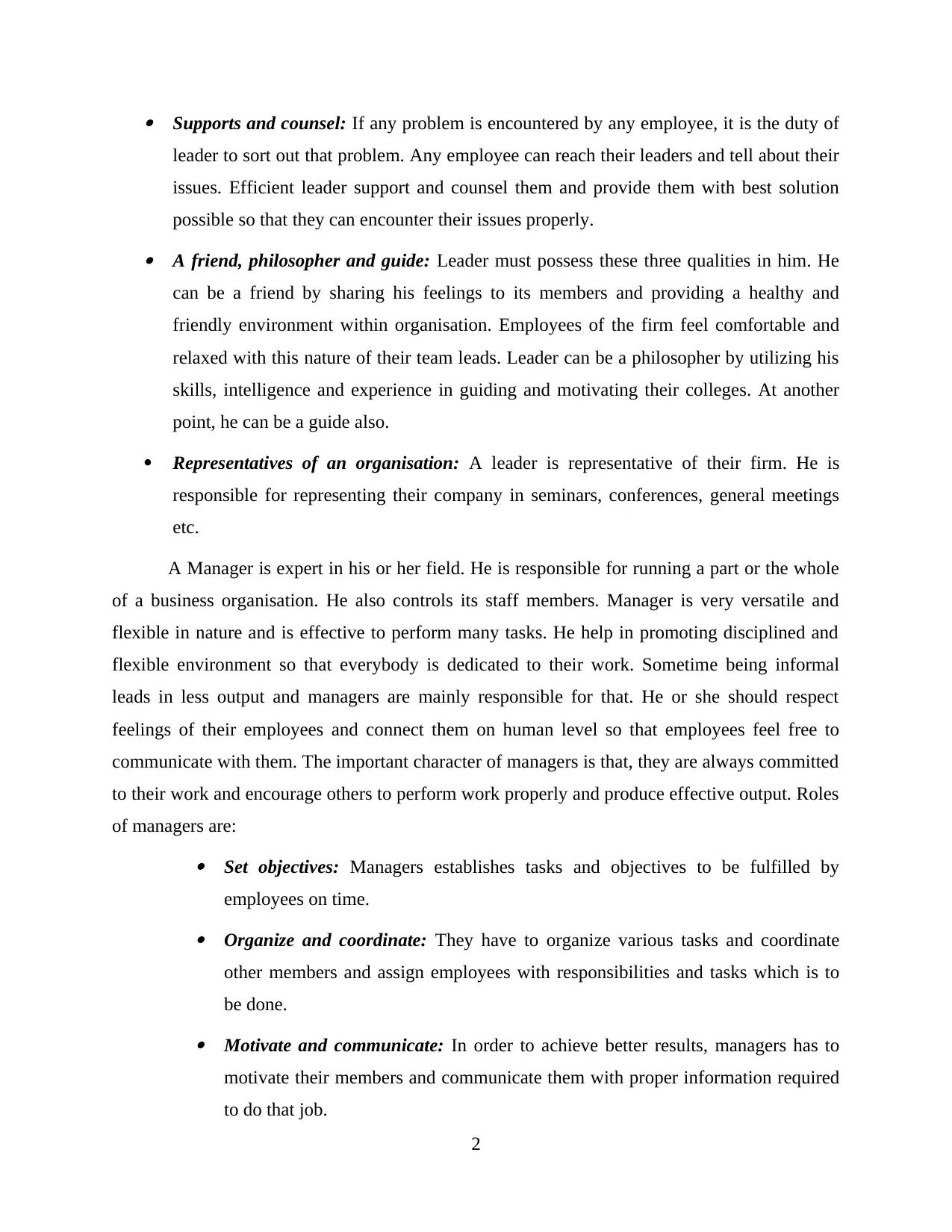
Supports and counsel: If any problem is encountered by any employee, it is the duty of
leader to sort out that problem. Any employee can reach their leaders and tell about their
issues. Efficient leader support and counsel them and provide them with best solution
possible so that they can encounter their issues properly. A friend, philosopher and guide: Leader must possess these three qualities in him. He
can be a friend by sharing his feelings to its members and providing a healthy and
friendly environment within organisation. Employees of the firm feel comfortable and
relaxed with this nature of their team leads. Leader can be a philosopher by utilizing his
skills, intelligence and experience in guiding and motivating their colleges. At another
point, he can be a guide also.
Representatives of an organisation: A leader is representative of their firm. He is
responsible for representing their company in seminars, conferences, general meetings
etc.
A Manager is expert in his or her field. He is responsible for running a part or the whole
of a business organisation. He also controls its staff members. Manager is very versatile and
flexible in nature and is effective to perform many tasks. He help in promoting disciplined and
flexible environment so that everybody is dedicated to their work. Sometime being informal
leads in less output and managers are mainly responsible for that. He or she should respect
feelings of their employees and connect them on human level so that employees feel free to
communicate with them. The important character of managers is that, they are always committed
to their work and encourage others to perform work properly and produce effective output. Roles
of managers are:
Set objectives: Managers establishes tasks and objectives to be fulfilled by
employees on time.
Organize and coordinate: They have to organize various tasks and coordinate
other members and assign employees with responsibilities and tasks which is to
be done.
Motivate and communicate: In order to achieve better results, managers has to
motivate their members and communicate them with proper information required
to do that job.
2
leader to sort out that problem. Any employee can reach their leaders and tell about their
issues. Efficient leader support and counsel them and provide them with best solution
possible so that they can encounter their issues properly. A friend, philosopher and guide: Leader must possess these three qualities in him. He
can be a friend by sharing his feelings to its members and providing a healthy and
friendly environment within organisation. Employees of the firm feel comfortable and
relaxed with this nature of their team leads. Leader can be a philosopher by utilizing his
skills, intelligence and experience in guiding and motivating their colleges. At another
point, he can be a guide also.
Representatives of an organisation: A leader is representative of their firm. He is
responsible for representing their company in seminars, conferences, general meetings
etc.
A Manager is expert in his or her field. He is responsible for running a part or the whole
of a business organisation. He also controls its staff members. Manager is very versatile and
flexible in nature and is effective to perform many tasks. He help in promoting disciplined and
flexible environment so that everybody is dedicated to their work. Sometime being informal
leads in less output and managers are mainly responsible for that. He or she should respect
feelings of their employees and connect them on human level so that employees feel free to
communicate with them. The important character of managers is that, they are always committed
to their work and encourage others to perform work properly and produce effective output. Roles
of managers are:
Set objectives: Managers establishes tasks and objectives to be fulfilled by
employees on time.
Organize and coordinate: They have to organize various tasks and coordinate
other members and assign employees with responsibilities and tasks which is to
be done.
Motivate and communicate: In order to achieve better results, managers has to
motivate their members and communicate them with proper information required
to do that job.
2
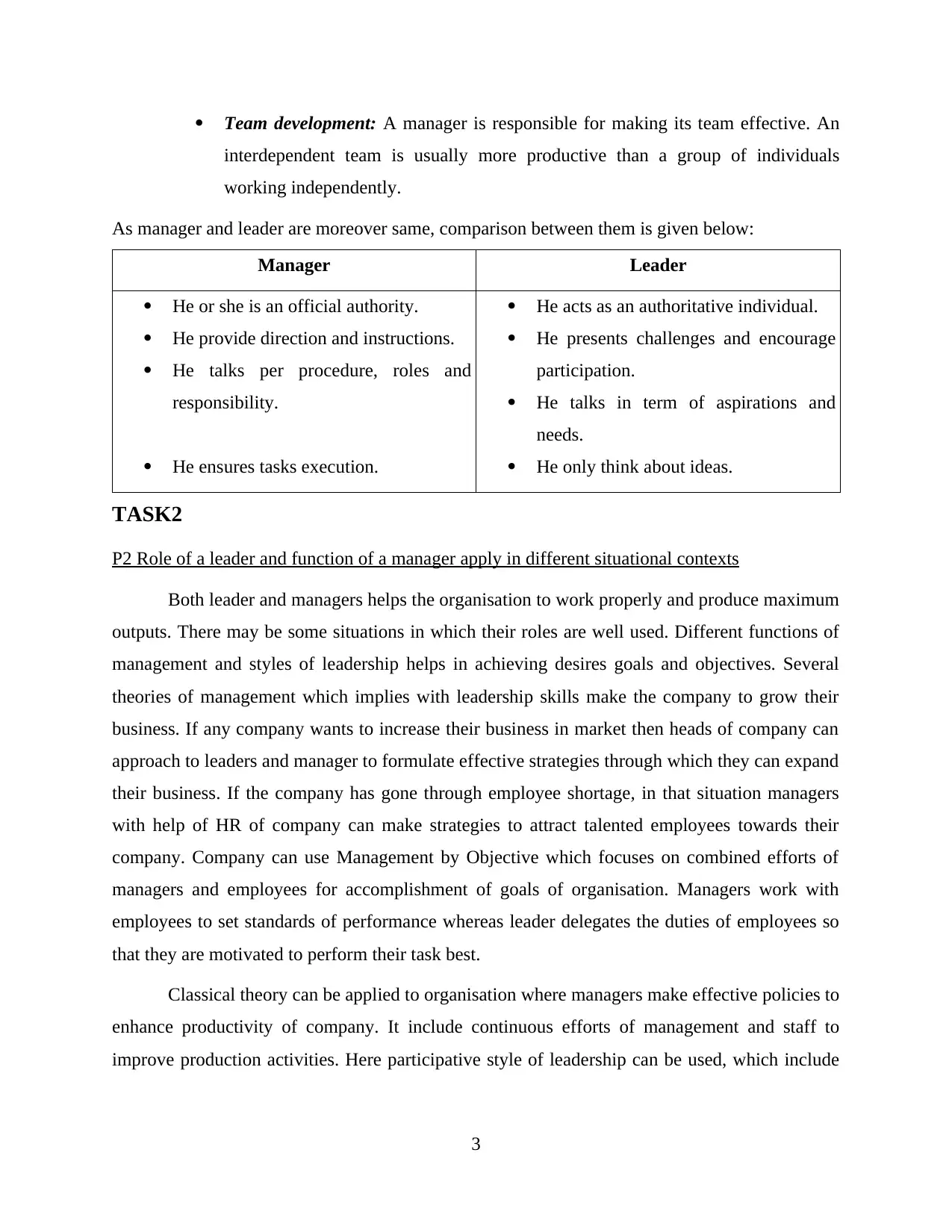
Team development: A manager is responsible for making its team effective. An
interdependent team is usually more productive than a group of individuals
working independently.
As manager and leader are moreover same, comparison between them is given below:
Manager Leader
He or she is an official authority.
He provide direction and instructions.
He talks per procedure, roles and
responsibility.
He ensures tasks execution.
He acts as an authoritative individual.
He presents challenges and encourage
participation.
He talks in term of aspirations and
needs.
He only think about ideas.
TASK2
P2 Role of a leader and function of a manager apply in different situational contexts
Both leader and managers helps the organisation to work properly and produce maximum
outputs. There may be some situations in which their roles are well used. Different functions of
management and styles of leadership helps in achieving desires goals and objectives. Several
theories of management which implies with leadership skills make the company to grow their
business. If any company wants to increase their business in market then heads of company can
approach to leaders and manager to formulate effective strategies through which they can expand
their business. If the company has gone through employee shortage, in that situation managers
with help of HR of company can make strategies to attract talented employees towards their
company. Company can use Management by Objective which focuses on combined efforts of
managers and employees for accomplishment of goals of organisation. Managers work with
employees to set standards of performance whereas leader delegates the duties of employees so
that they are motivated to perform their task best.
Classical theory can be applied to organisation where managers make effective policies to
enhance productivity of company. It include continuous efforts of management and staff to
improve production activities. Here participative style of leadership can be used, which include
3
interdependent team is usually more productive than a group of individuals
working independently.
As manager and leader are moreover same, comparison between them is given below:
Manager Leader
He or she is an official authority.
He provide direction and instructions.
He talks per procedure, roles and
responsibility.
He ensures tasks execution.
He acts as an authoritative individual.
He presents challenges and encourage
participation.
He talks in term of aspirations and
needs.
He only think about ideas.
TASK2
P2 Role of a leader and function of a manager apply in different situational contexts
Both leader and managers helps the organisation to work properly and produce maximum
outputs. There may be some situations in which their roles are well used. Different functions of
management and styles of leadership helps in achieving desires goals and objectives. Several
theories of management which implies with leadership skills make the company to grow their
business. If any company wants to increase their business in market then heads of company can
approach to leaders and manager to formulate effective strategies through which they can expand
their business. If the company has gone through employee shortage, in that situation managers
with help of HR of company can make strategies to attract talented employees towards their
company. Company can use Management by Objective which focuses on combined efforts of
managers and employees for accomplishment of goals of organisation. Managers work with
employees to set standards of performance whereas leader delegates the duties of employees so
that they are motivated to perform their task best.
Classical theory can be applied to organisation where managers make effective policies to
enhance productivity of company. It include continuous efforts of management and staff to
improve production activities. Here participative style of leadership can be used, which include
3
⊘ This is a preview!⊘
Do you want full access?
Subscribe today to unlock all pages.

Trusted by 1+ million students worldwide
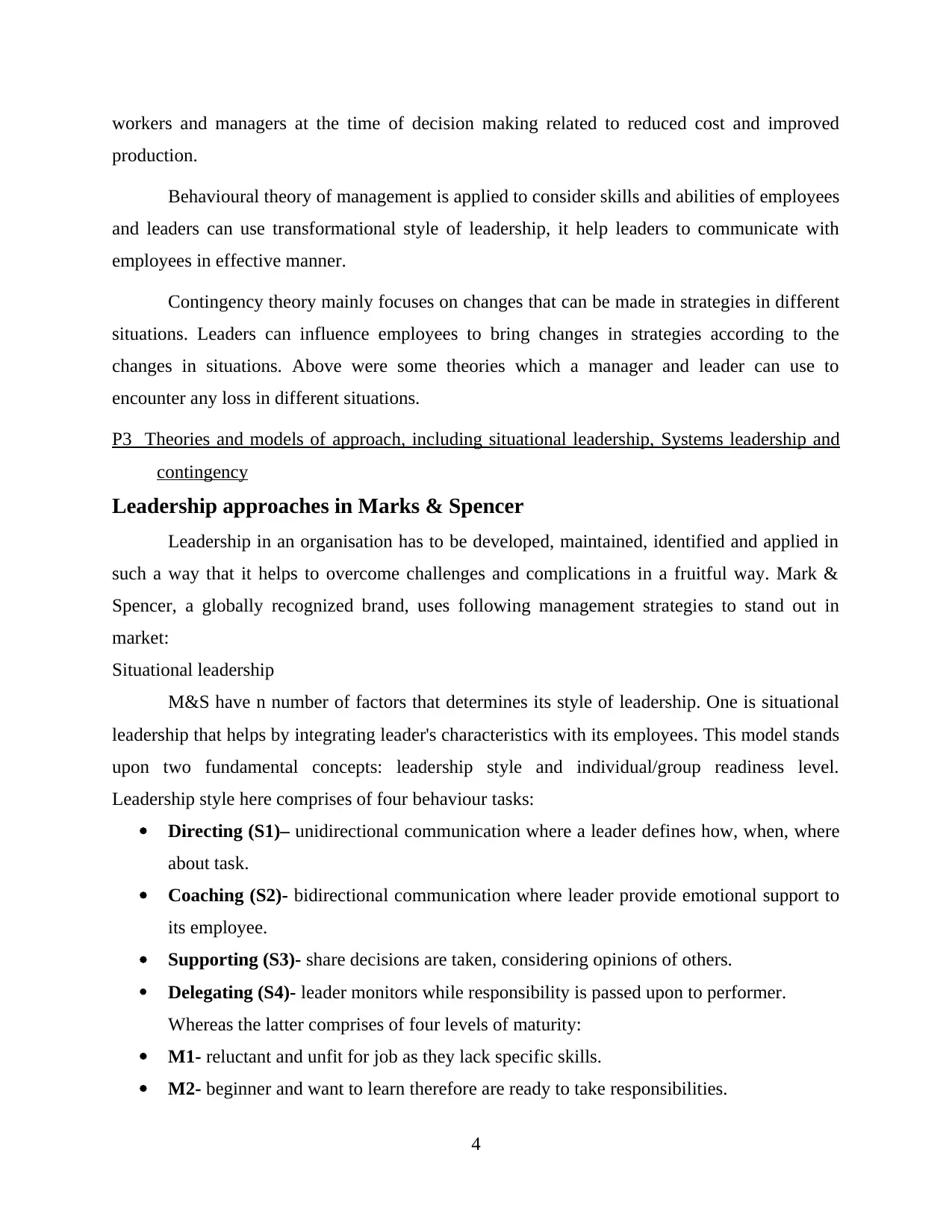
workers and managers at the time of decision making related to reduced cost and improved
production.
Behavioural theory of management is applied to consider skills and abilities of employees
and leaders can use transformational style of leadership, it help leaders to communicate with
employees in effective manner.
Contingency theory mainly focuses on changes that can be made in strategies in different
situations. Leaders can influence employees to bring changes in strategies according to the
changes in situations. Above were some theories which a manager and leader can use to
encounter any loss in different situations.
P3 Theories and models of approach, including situational leadership, Systems leadership and
contingency
Leadership approaches in Marks & Spencer
Leadership in an organisation has to be developed, maintained, identified and applied in
such a way that it helps to overcome challenges and complications in a fruitful way. Mark &
Spencer, a globally recognized brand, uses following management strategies to stand out in
market:
Situational leadership
M&S have n number of factors that determines its style of leadership. One is situational
leadership that helps by integrating leader's characteristics with its employees. This model stands
upon two fundamental concepts: leadership style and individual/group readiness level.
Leadership style here comprises of four behaviour tasks:
Directing (S1)– unidirectional communication where a leader defines how, when, where
about task.
Coaching (S2)- bidirectional communication where leader provide emotional support to
its employee.
Supporting (S3)- share decisions are taken, considering opinions of others.
Delegating (S4)- leader monitors while responsibility is passed upon to performer.
Whereas the latter comprises of four levels of maturity:
M1- reluctant and unfit for job as they lack specific skills.
M2- beginner and want to learn therefore are ready to take responsibilities.
4
production.
Behavioural theory of management is applied to consider skills and abilities of employees
and leaders can use transformational style of leadership, it help leaders to communicate with
employees in effective manner.
Contingency theory mainly focuses on changes that can be made in strategies in different
situations. Leaders can influence employees to bring changes in strategies according to the
changes in situations. Above were some theories which a manager and leader can use to
encounter any loss in different situations.
P3 Theories and models of approach, including situational leadership, Systems leadership and
contingency
Leadership approaches in Marks & Spencer
Leadership in an organisation has to be developed, maintained, identified and applied in
such a way that it helps to overcome challenges and complications in a fruitful way. Mark &
Spencer, a globally recognized brand, uses following management strategies to stand out in
market:
Situational leadership
M&S have n number of factors that determines its style of leadership. One is situational
leadership that helps by integrating leader's characteristics with its employees. This model stands
upon two fundamental concepts: leadership style and individual/group readiness level.
Leadership style here comprises of four behaviour tasks:
Directing (S1)– unidirectional communication where a leader defines how, when, where
about task.
Coaching (S2)- bidirectional communication where leader provide emotional support to
its employee.
Supporting (S3)- share decisions are taken, considering opinions of others.
Delegating (S4)- leader monitors while responsibility is passed upon to performer.
Whereas the latter comprises of four levels of maturity:
M1- reluctant and unfit for job as they lack specific skills.
M2- beginner and want to learn therefore are ready to take responsibilities.
4
Paraphrase This Document
Need a fresh take? Get an instant paraphrase of this document with our AI Paraphraser
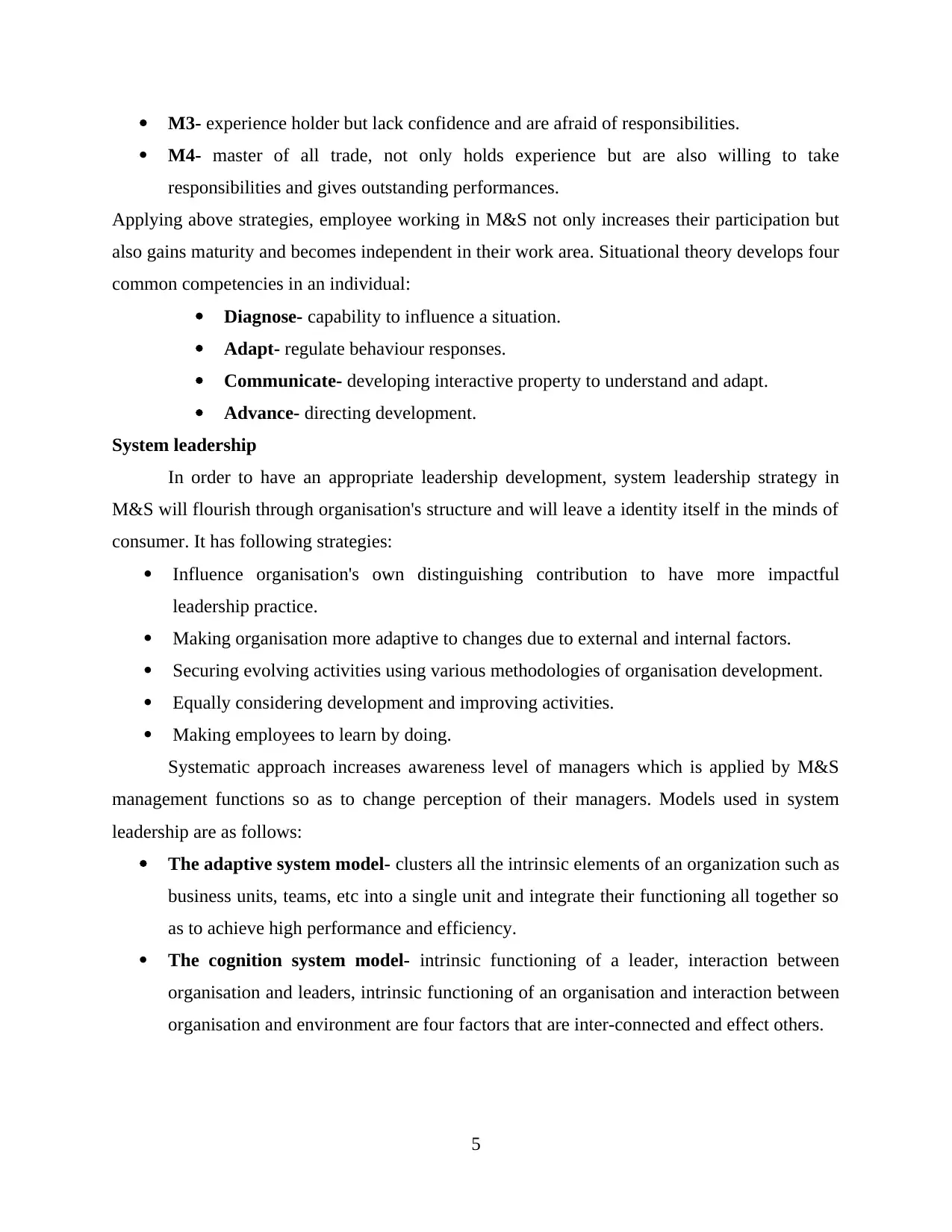
M3- experience holder but lack confidence and are afraid of responsibilities.
M4- master of all trade, not only holds experience but are also willing to take
responsibilities and gives outstanding performances.
Applying above strategies, employee working in M&S not only increases their participation but
also gains maturity and becomes independent in their work area. Situational theory develops four
common competencies in an individual:
Diagnose- capability to influence a situation.
Adapt- regulate behaviour responses.
Communicate- developing interactive property to understand and adapt.
Advance- directing development.
System leadership
In order to have an appropriate leadership development, system leadership strategy in
M&S will flourish through organisation's structure and will leave a identity itself in the minds of
consumer. It has following strategies:
Influence organisation's own distinguishing contribution to have more impactful
leadership practice.
Making organisation more adaptive to changes due to external and internal factors.
Securing evolving activities using various methodologies of organisation development.
Equally considering development and improving activities.
Making employees to learn by doing.
Systematic approach increases awareness level of managers which is applied by M&S
management functions so as to change perception of their managers. Models used in system
leadership are as follows:
The adaptive system model- clusters all the intrinsic elements of an organization such as
business units, teams, etc into a single unit and integrate their functioning all together so
as to achieve high performance and efficiency.
The cognition system model- intrinsic functioning of a leader, interaction between
organisation and leaders, intrinsic functioning of an organisation and interaction between
organisation and environment are four factors that are inter-connected and effect others.
5
M4- master of all trade, not only holds experience but are also willing to take
responsibilities and gives outstanding performances.
Applying above strategies, employee working in M&S not only increases their participation but
also gains maturity and becomes independent in their work area. Situational theory develops four
common competencies in an individual:
Diagnose- capability to influence a situation.
Adapt- regulate behaviour responses.
Communicate- developing interactive property to understand and adapt.
Advance- directing development.
System leadership
In order to have an appropriate leadership development, system leadership strategy in
M&S will flourish through organisation's structure and will leave a identity itself in the minds of
consumer. It has following strategies:
Influence organisation's own distinguishing contribution to have more impactful
leadership practice.
Making organisation more adaptive to changes due to external and internal factors.
Securing evolving activities using various methodologies of organisation development.
Equally considering development and improving activities.
Making employees to learn by doing.
Systematic approach increases awareness level of managers which is applied by M&S
management functions so as to change perception of their managers. Models used in system
leadership are as follows:
The adaptive system model- clusters all the intrinsic elements of an organization such as
business units, teams, etc into a single unit and integrate their functioning all together so
as to achieve high performance and efficiency.
The cognition system model- intrinsic functioning of a leader, interaction between
organisation and leaders, intrinsic functioning of an organisation and interaction between
organisation and environment are four factors that are inter-connected and effect others.
5
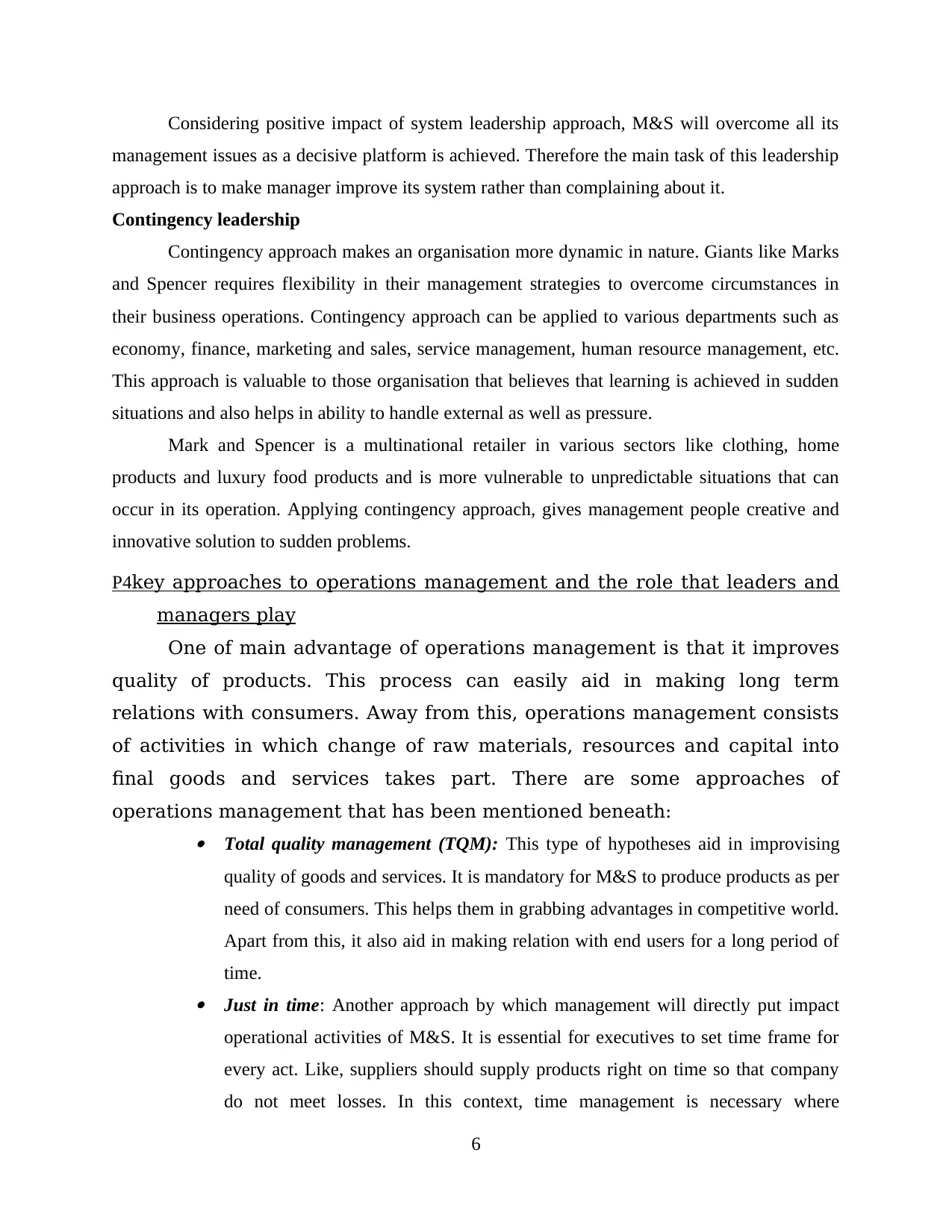
Considering positive impact of system leadership approach, M&S will overcome all its
management issues as a decisive platform is achieved. Therefore the main task of this leadership
approach is to make manager improve its system rather than complaining about it.
Contingency leadership
Contingency approach makes an organisation more dynamic in nature. Giants like Marks
and Spencer requires flexibility in their management strategies to overcome circumstances in
their business operations. Contingency approach can be applied to various departments such as
economy, finance, marketing and sales, service management, human resource management, etc.
This approach is valuable to those organisation that believes that learning is achieved in sudden
situations and also helps in ability to handle external as well as pressure.
Mark and Spencer is a multinational retailer in various sectors like clothing, home
products and luxury food products and is more vulnerable to unpredictable situations that can
occur in its operation. Applying contingency approach, gives management people creative and
innovative solution to sudden problems.
P4key approaches to operations management and the role that leaders and
managers play
One of main advantage of operations management is that it improves
quality of products. This process can easily aid in making long term
relations with consumers. Away from this, operations management consists
of activities in which change of raw materials, resources and capital into
final goods and services takes part. There are some approaches of
operations management that has been mentioned beneath:
Total quality management (TQM): This type of hypotheses aid in improvising
quality of goods and services. It is mandatory for M&S to produce products as per
need of consumers. This helps them in grabbing advantages in competitive world.
Apart from this, it also aid in making relation with end users for a long period of
time.
Just in time: Another approach by which management will directly put impact
operational activities of M&S. It is essential for executives to set time frame for
every act. Like, suppliers should supply products right on time so that company
do not meet losses. In this context, time management is necessary where
6
management issues as a decisive platform is achieved. Therefore the main task of this leadership
approach is to make manager improve its system rather than complaining about it.
Contingency leadership
Contingency approach makes an organisation more dynamic in nature. Giants like Marks
and Spencer requires flexibility in their management strategies to overcome circumstances in
their business operations. Contingency approach can be applied to various departments such as
economy, finance, marketing and sales, service management, human resource management, etc.
This approach is valuable to those organisation that believes that learning is achieved in sudden
situations and also helps in ability to handle external as well as pressure.
Mark and Spencer is a multinational retailer in various sectors like clothing, home
products and luxury food products and is more vulnerable to unpredictable situations that can
occur in its operation. Applying contingency approach, gives management people creative and
innovative solution to sudden problems.
P4key approaches to operations management and the role that leaders and
managers play
One of main advantage of operations management is that it improves
quality of products. This process can easily aid in making long term
relations with consumers. Away from this, operations management consists
of activities in which change of raw materials, resources and capital into
final goods and services takes part. There are some approaches of
operations management that has been mentioned beneath:
Total quality management (TQM): This type of hypotheses aid in improvising
quality of goods and services. It is mandatory for M&S to produce products as per
need of consumers. This helps them in grabbing advantages in competitive world.
Apart from this, it also aid in making relation with end users for a long period of
time.
Just in time: Another approach by which management will directly put impact
operational activities of M&S. It is essential for executives to set time frame for
every act. Like, suppliers should supply products right on time so that company
do not meet losses. In this context, time management is necessary where
6
⊘ This is a preview!⊘
Do you want full access?
Subscribe today to unlock all pages.

Trusted by 1+ million students worldwide
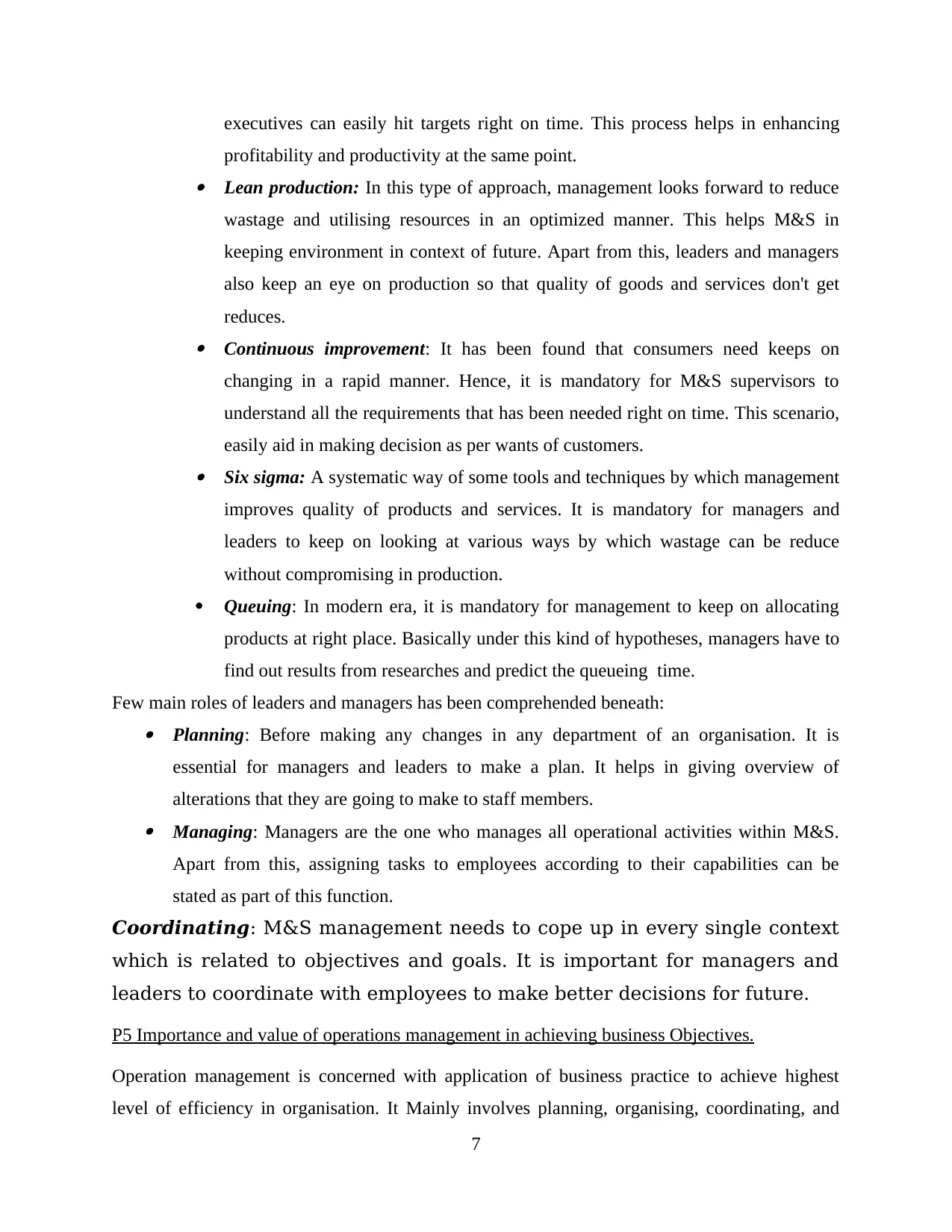
executives can easily hit targets right on time. This process helps in enhancing
profitability and productivity at the same point.
Lean production: In this type of approach, management looks forward to reduce
wastage and utilising resources in an optimized manner. This helps M&S in
keeping environment in context of future. Apart from this, leaders and managers
also keep an eye on production so that quality of goods and services don't get
reduces.
Continuous improvement: It has been found that consumers need keeps on
changing in a rapid manner. Hence, it is mandatory for M&S supervisors to
understand all the requirements that has been needed right on time. This scenario,
easily aid in making decision as per wants of customers.
Six sigma: A systematic way of some tools and techniques by which management
improves quality of products and services. It is mandatory for managers and
leaders to keep on looking at various ways by which wastage can be reduce
without compromising in production.
Queuing: In modern era, it is mandatory for management to keep on allocating
products at right place. Basically under this kind of hypotheses, managers have to
find out results from researches and predict the queueing time.
Few main roles of leaders and managers has been comprehended beneath: Planning: Before making any changes in any department of an organisation. It is
essential for managers and leaders to make a plan. It helps in giving overview of
alterations that they are going to make to staff members. Managing: Managers are the one who manages all operational activities within M&S.
Apart from this, assigning tasks to employees according to their capabilities can be
stated as part of this function.
Coordinating: M&S management needs to cope up in every single context
which is related to objectives and goals. It is important for managers and
leaders to coordinate with employees to make better decisions for future.
P5 Importance and value of operations management in achieving business Objectives.
Operation management is concerned with application of business practice to achieve highest
level of efficiency in organisation. It Mainly involves planning, organising, coordinating, and
7
profitability and productivity at the same point.
Lean production: In this type of approach, management looks forward to reduce
wastage and utilising resources in an optimized manner. This helps M&S in
keeping environment in context of future. Apart from this, leaders and managers
also keep an eye on production so that quality of goods and services don't get
reduces.
Continuous improvement: It has been found that consumers need keeps on
changing in a rapid manner. Hence, it is mandatory for M&S supervisors to
understand all the requirements that has been needed right on time. This scenario,
easily aid in making decision as per wants of customers.
Six sigma: A systematic way of some tools and techniques by which management
improves quality of products and services. It is mandatory for managers and
leaders to keep on looking at various ways by which wastage can be reduce
without compromising in production.
Queuing: In modern era, it is mandatory for management to keep on allocating
products at right place. Basically under this kind of hypotheses, managers have to
find out results from researches and predict the queueing time.
Few main roles of leaders and managers has been comprehended beneath: Planning: Before making any changes in any department of an organisation. It is
essential for managers and leaders to make a plan. It helps in giving overview of
alterations that they are going to make to staff members. Managing: Managers are the one who manages all operational activities within M&S.
Apart from this, assigning tasks to employees according to their capabilities can be
stated as part of this function.
Coordinating: M&S management needs to cope up in every single context
which is related to objectives and goals. It is important for managers and
leaders to coordinate with employees to make better decisions for future.
P5 Importance and value of operations management in achieving business Objectives.
Operation management is concerned with application of business practice to achieve highest
level of efficiency in organisation. It Mainly involves planning, organising, coordinating, and
7
Paraphrase This Document
Need a fresh take? Get an instant paraphrase of this document with our AI Paraphraser
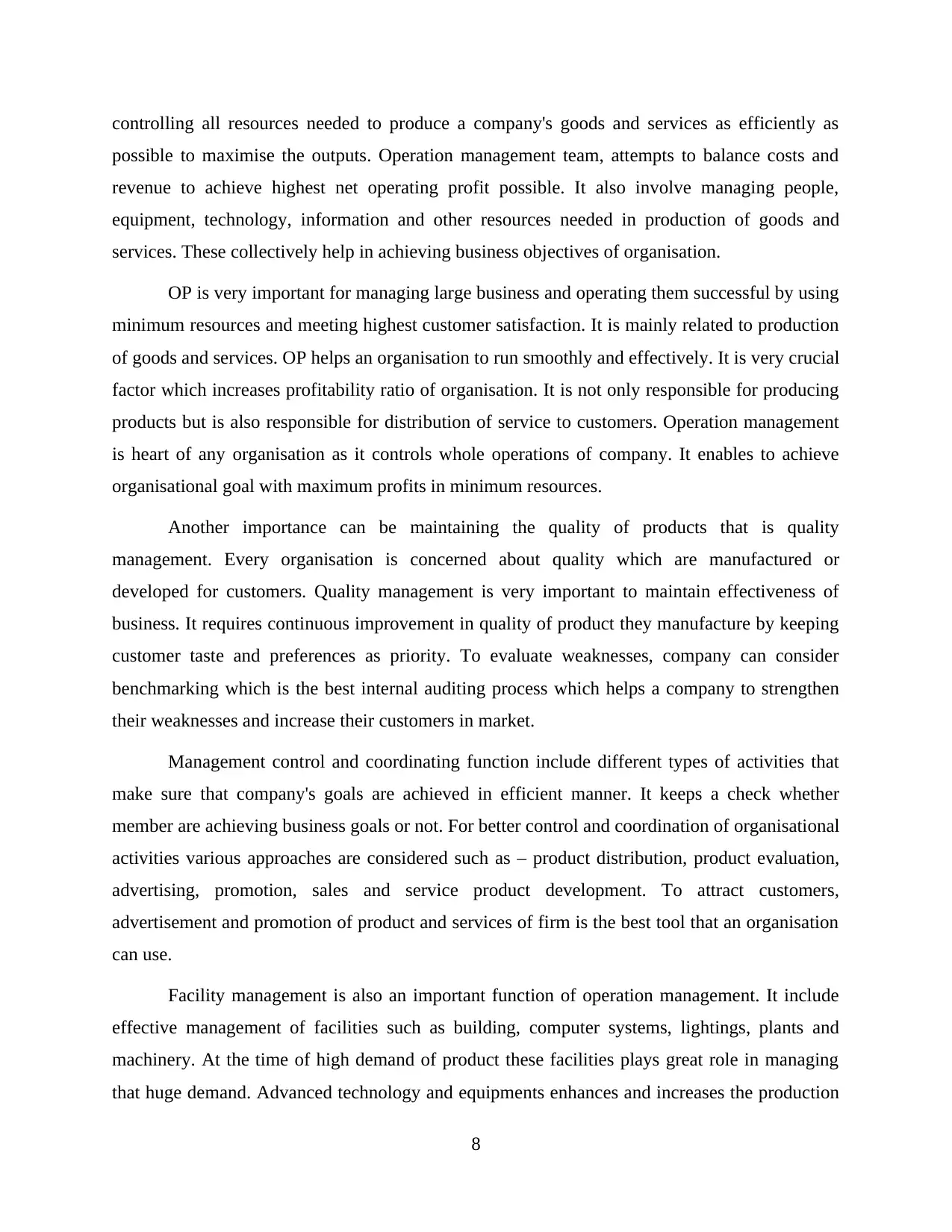
controlling all resources needed to produce a company's goods and services as efficiently as
possible to maximise the outputs. Operation management team, attempts to balance costs and
revenue to achieve highest net operating profit possible. It also involve managing people,
equipment, technology, information and other resources needed in production of goods and
services. These collectively help in achieving business objectives of organisation.
OP is very important for managing large business and operating them successful by using
minimum resources and meeting highest customer satisfaction. It is mainly related to production
of goods and services. OP helps an organisation to run smoothly and effectively. It is very crucial
factor which increases profitability ratio of organisation. It is not only responsible for producing
products but is also responsible for distribution of service to customers. Operation management
is heart of any organisation as it controls whole operations of company. It enables to achieve
organisational goal with maximum profits in minimum resources.
Another importance can be maintaining the quality of products that is quality
management. Every organisation is concerned about quality which are manufactured or
developed for customers. Quality management is very important to maintain effectiveness of
business. It requires continuous improvement in quality of product they manufacture by keeping
customer taste and preferences as priority. To evaluate weaknesses, company can consider
benchmarking which is the best internal auditing process which helps a company to strengthen
their weaknesses and increase their customers in market.
Management control and coordinating function include different types of activities that
make sure that company's goals are achieved in efficient manner. It keeps a check whether
member are achieving business goals or not. For better control and coordination of organisational
activities various approaches are considered such as – product distribution, product evaluation,
advertising, promotion, sales and service product development. To attract customers,
advertisement and promotion of product and services of firm is the best tool that an organisation
can use.
Facility management is also an important function of operation management. It include
effective management of facilities such as building, computer systems, lightings, plants and
machinery. At the time of high demand of product these facilities plays great role in managing
that huge demand. Advanced technology and equipments enhances and increases the production
8
possible to maximise the outputs. Operation management team, attempts to balance costs and
revenue to achieve highest net operating profit possible. It also involve managing people,
equipment, technology, information and other resources needed in production of goods and
services. These collectively help in achieving business objectives of organisation.
OP is very important for managing large business and operating them successful by using
minimum resources and meeting highest customer satisfaction. It is mainly related to production
of goods and services. OP helps an organisation to run smoothly and effectively. It is very crucial
factor which increases profitability ratio of organisation. It is not only responsible for producing
products but is also responsible for distribution of service to customers. Operation management
is heart of any organisation as it controls whole operations of company. It enables to achieve
organisational goal with maximum profits in minimum resources.
Another importance can be maintaining the quality of products that is quality
management. Every organisation is concerned about quality which are manufactured or
developed for customers. Quality management is very important to maintain effectiveness of
business. It requires continuous improvement in quality of product they manufacture by keeping
customer taste and preferences as priority. To evaluate weaknesses, company can consider
benchmarking which is the best internal auditing process which helps a company to strengthen
their weaknesses and increase their customers in market.
Management control and coordinating function include different types of activities that
make sure that company's goals are achieved in efficient manner. It keeps a check whether
member are achieving business goals or not. For better control and coordination of organisational
activities various approaches are considered such as – product distribution, product evaluation,
advertising, promotion, sales and service product development. To attract customers,
advertisement and promotion of product and services of firm is the best tool that an organisation
can use.
Facility management is also an important function of operation management. It include
effective management of facilities such as building, computer systems, lightings, plants and
machinery. At the time of high demand of product these facilities plays great role in managing
that huge demand. Advanced technology and equipments enhances and increases the production
8
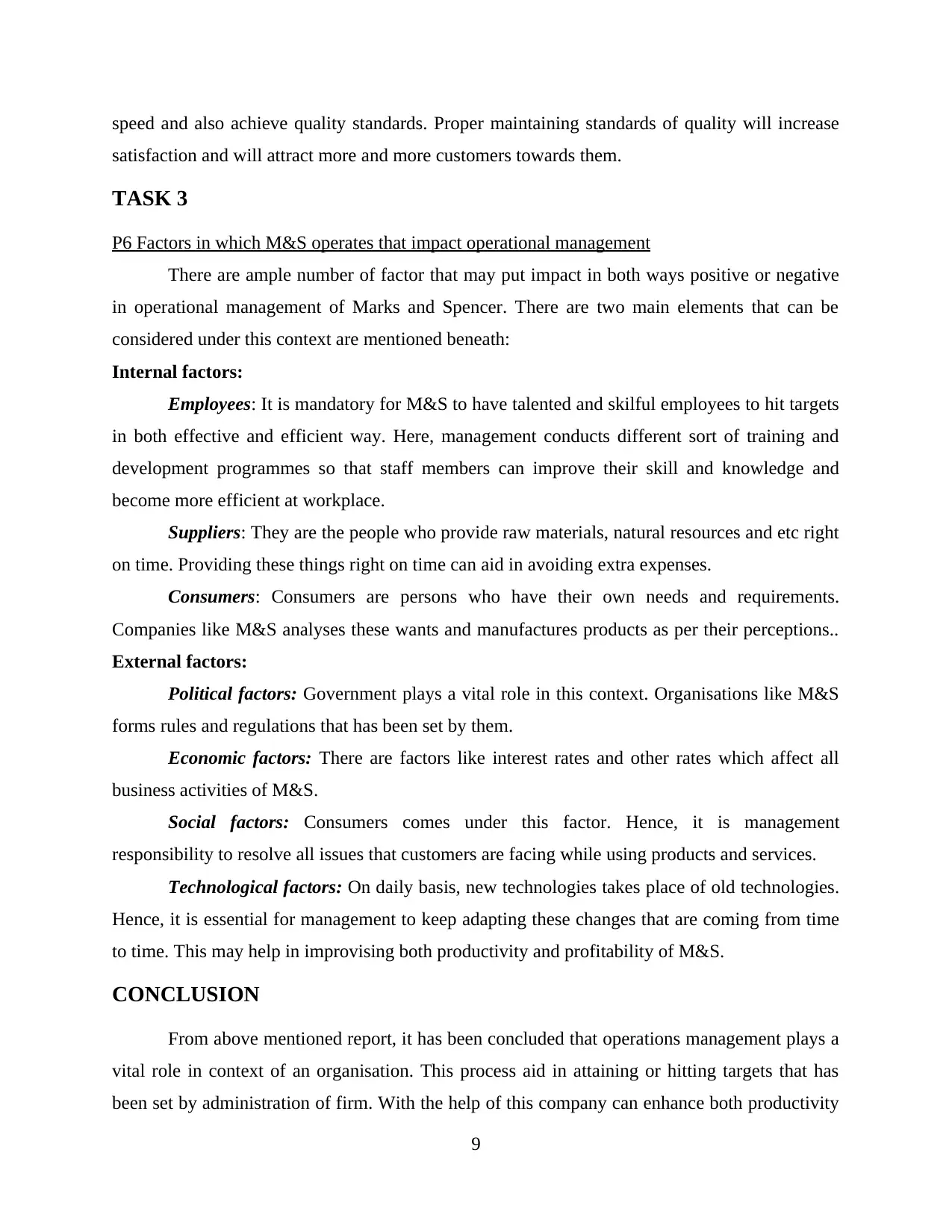
speed and also achieve quality standards. Proper maintaining standards of quality will increase
satisfaction and will attract more and more customers towards them.
TASK 3
P6 Factors in which M&S operates that impact operational management
There are ample number of factor that may put impact in both ways positive or negative
in operational management of Marks and Spencer. There are two main elements that can be
considered under this context are mentioned beneath:
Internal factors:
Employees: It is mandatory for M&S to have talented and skilful employees to hit targets
in both effective and efficient way. Here, management conducts different sort of training and
development programmes so that staff members can improve their skill and knowledge and
become more efficient at workplace.
Suppliers: They are the people who provide raw materials, natural resources and etc right
on time. Providing these things right on time can aid in avoiding extra expenses.
Consumers: Consumers are persons who have their own needs and requirements.
Companies like M&S analyses these wants and manufactures products as per their perceptions..
External factors:
Political factors: Government plays a vital role in this context. Organisations like M&S
forms rules and regulations that has been set by them.
Economic factors: There are factors like interest rates and other rates which affect all
business activities of M&S.
Social factors: Consumers comes under this factor. Hence, it is management
responsibility to resolve all issues that customers are facing while using products and services.
Technological factors: On daily basis, new technologies takes place of old technologies.
Hence, it is essential for management to keep adapting these changes that are coming from time
to time. This may help in improvising both productivity and profitability of M&S.
CONCLUSION
From above mentioned report, it has been concluded that operations management plays a
vital role in context of an organisation. This process aid in attaining or hitting targets that has
been set by administration of firm. With the help of this company can enhance both productivity
9
satisfaction and will attract more and more customers towards them.
TASK 3
P6 Factors in which M&S operates that impact operational management
There are ample number of factor that may put impact in both ways positive or negative
in operational management of Marks and Spencer. There are two main elements that can be
considered under this context are mentioned beneath:
Internal factors:
Employees: It is mandatory for M&S to have talented and skilful employees to hit targets
in both effective and efficient way. Here, management conducts different sort of training and
development programmes so that staff members can improve their skill and knowledge and
become more efficient at workplace.
Suppliers: They are the people who provide raw materials, natural resources and etc right
on time. Providing these things right on time can aid in avoiding extra expenses.
Consumers: Consumers are persons who have their own needs and requirements.
Companies like M&S analyses these wants and manufactures products as per their perceptions..
External factors:
Political factors: Government plays a vital role in this context. Organisations like M&S
forms rules and regulations that has been set by them.
Economic factors: There are factors like interest rates and other rates which affect all
business activities of M&S.
Social factors: Consumers comes under this factor. Hence, it is management
responsibility to resolve all issues that customers are facing while using products and services.
Technological factors: On daily basis, new technologies takes place of old technologies.
Hence, it is essential for management to keep adapting these changes that are coming from time
to time. This may help in improvising both productivity and profitability of M&S.
CONCLUSION
From above mentioned report, it has been concluded that operations management plays a
vital role in context of an organisation. This process aid in attaining or hitting targets that has
been set by administration of firm. With the help of this company can enhance both productivity
9
⊘ This is a preview!⊘
Do you want full access?
Subscribe today to unlock all pages.

Trusted by 1+ million students worldwide
1 out of 15
Related Documents
Your All-in-One AI-Powered Toolkit for Academic Success.
+13062052269
info@desklib.com
Available 24*7 on WhatsApp / Email
![[object Object]](/_next/static/media/star-bottom.7253800d.svg)
Unlock your academic potential
Copyright © 2020–2025 A2Z Services. All Rights Reserved. Developed and managed by ZUCOL.





